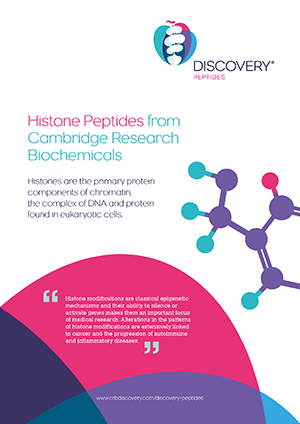Histone H3 (1-15) K4Me3, K9Ac, pS10 1mg
ART-[K(Me3)]-QTAR-[K(Ac)]-[pS]-TGGKA-acid
Description
Application Data
Description
-
Histone 3 (H3) is one of the four core histones fundamental for compacting eukaryotic DNA into the nucleosome. Lysine 4 ofthis peptide has been tri-methylated, lysine 9 has been acetylated and serine 10 has been phosphorylated.
Application Data
-

Material Safety Data Sheet (MSDS)Catalogue number crb1001702j Molecular Weight 1724.9 Sequence (one letter code) ART-[K(Me3)]-QTAR-[K(Ac)]-[pS]-TGGKA-acid
Sequence (three letter code) H-Ala-Arg-Thr-[Lys(Me3)]-Gln-Thr-Ala-Arg-[Lys(Ac)]-[pS]-Thr-Gly-Gly-Lys-Ala-OH
Purity >95% Storage -20°C References Hyland et al., (2005). Insights into the Role of Histone H3 and Histone H4 Core Modifiable Residues in Saccharomyces cerevisiae. Mol. Cell. Bio. 22 10060. PMID: 16260619
Henneman et al., (2018). Structure and function of archaeal histones. PLoS Genet. 14(9) e1007582 DOI: https://doi.org/10.1371/journal.pgen.1007582
Stewart et al., (2015). Dynamic changes in histone modifications precede de novo DNA methylation in oocytes. Genes Dev. PMID: 26584620
Manufactured in: United Kingdom Histone 3 (H3) is one of the four core histones (H2A, H2B, H3 and H4) fundamental in compacting eukaryotic DNA into the nucleosome. The nucleosome arises when 147 base pairs of DNA wrap around a H3-H4 tetramer and two H2A-H2B dimers, forming the histone octamer core. Both H4 and H3 are highly conserved and perform roles in binding to segments of DNA which enter and leave the nucleosome and in chromatin formation. Similar to the other core histone, H3 has a globular domain and a flexible N-terminal domain, “histone tail” which can undergo modifications such as acetylation, methylation, phosphorylation and ubiquitination. The transcriptional activation or silencing of the chromatin is controlled by ATP-dependent chromatin remodelling factors and histone modifying enzymes which target histone proteins. Both processes function to alter the positioning of the nucleosome, allowing the DNA it to be either available or inaccessible to the transcription machinery.
The lysine at position 4 of this peptide has been tri-methylated and it is implicated in studies that this modification may remodel the chromatin so that it is more accessible to transcription factors, which may ultimately increase the level of gene expression. The lysine at position 9 has been acetylated, which neutralizes the positive charge on the amino acid, loosening the chromatin structure. This alteration to the accessibility of chromatin promotes the initiation of transcription. Moreover, the serine at position 10 has been phosphorylated, and studies have suggested that this may induce chromatin condensation, and subsequently repress transcription and gene expression.
You may also like…
-
Histone H3 (1-20) K4Me3-GG-[Lys(5-FAM)]ART-[K(Me3)]-QTARKSTGGKAPRKQL-GG-[K(5-FAM)]-amide
View products -
[5-FAM] Histone H3 (1-14) K4Me3
ART-[K(Me3)]-QTARKSTGGK-[5-FAM]-amide
View products -
Histone H3 (1-21) K4Me3
ART-[K(Me3)]-QTARKSTGGKAPRKQLA-acid
View products -
Histone H3 (1-20) K4Me3, K9Ac-GG-[Lys(5-FAM)]ART-[K(Me3)]-QTAR-[K(Ac)]-STGGKAPRKQL-GG-[K(5-FAM)]-amide
View products -
Biotin-Histone H3 (14-34) pT22 K23Me3
Biotin-KAPRKQLA-[pT]-[K(Me)3]-AARKSAPATGG-acid
View products -
Histone H3 (1-22) K4Me3-Biotin
ART-[K(Me)3]-QTARKSTGGKAPRKQLAK-peg-biotin
View products -
Histone H3 (1-18)ARTKQTARKSTGGKAPRK-acid
View products -
Biotin-Histone H3 (14-34) K23Me3Biotin-KAPRKQLAT-[K(Me)3]-AARKSAPATGG-acid, Where K(Me)3 is Tri-Methylated Lysine
View products


